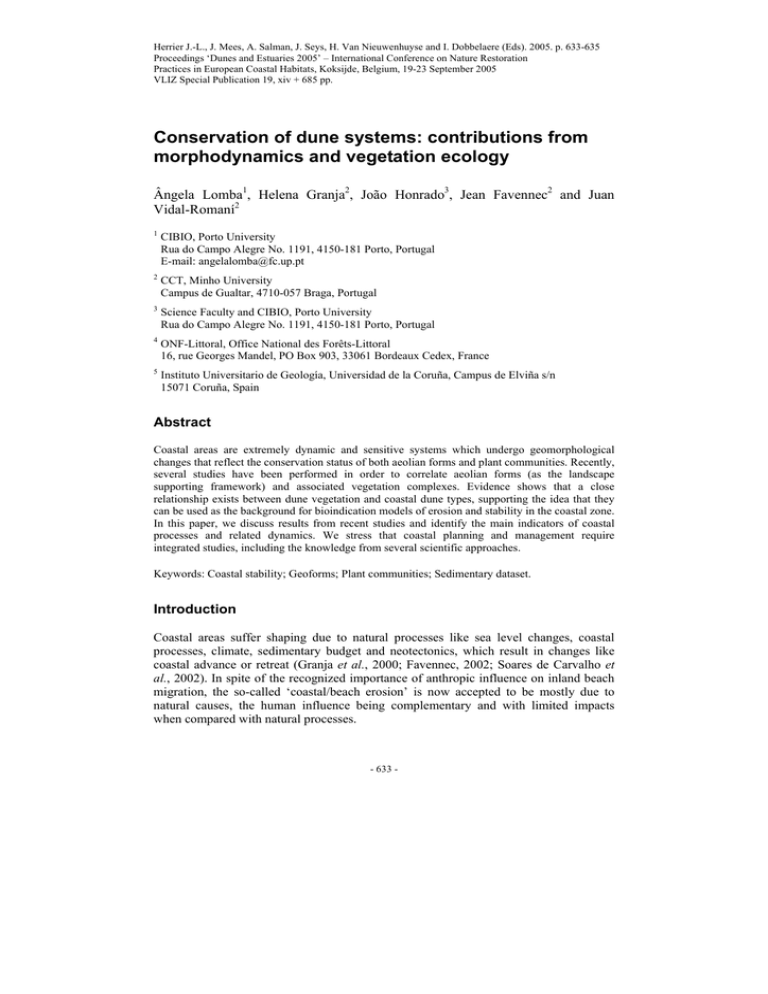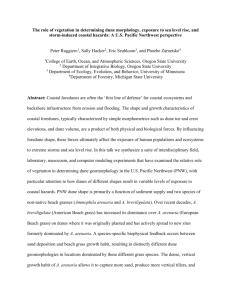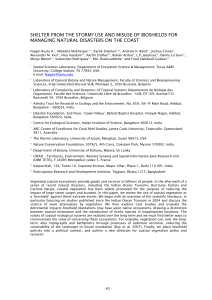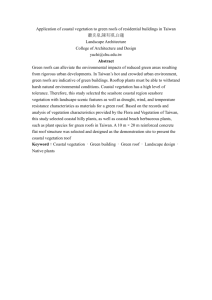Document 12903396
advertisement

Herrier J.-L., J. Mees, A. Salman, J. Seys, H. Van Nieuwenhuyse and I. Dobbelaere (Eds). 2005. p. 633-635 Proceedings ‘Dunes and Estuaries 2005’ – International Conference on Nature Restoration Practices in European Coastal Habitats, Koksijde, Belgium, 19-23 September 2005 VLIZ Special Publication 19, xiv + 685 pp. Conservation of dune systems: contributions from morphodynamics and vegetation ecology Ângela Lomba1, Helena Granja2, João Honrado3, Jean Favennec2 and Juan Vidal-Romaní2 1 CIBIO, Porto University Rua do Campo Alegre No. 1191, 4150-181 Porto, Portugal E-mail: angelalomba@fc.up.pt 2 CCT, Minho University Campus de Gualtar, 4710-057 Braga, Portugal 3 Science Faculty and CIBIO, Porto University Rua do Campo Alegre No. 1191, 4150-181 Porto, Portugal 4 ONF-Littoral, Office National des Forêts-Littoral 16, rue Georges Mandel, PO Box 903, 33061 Bordeaux Cedex, France 5 Instituto Universitario de Geología, Universidad de la Coruña, Campus de Elviña s/n 15071 Coruña, Spain Abstract Coastal areas are extremely dynamic and sensitive systems which undergo geomorphological changes that reflect the conservation status of both aeolian forms and plant communities. Recently, several studies have been performed in order to correlate aeolian forms (as the landscape supporting framework) and associated vegetation complexes. Evidence shows that a close relationship exists between dune vegetation and coastal dune types, supporting the idea that they can be used as the background for bioindication models of erosion and stability in the coastal zone. In this paper, we discuss results from recent studies and identify the main indicators of coastal processes and related dynamics. We stress that coastal planning and management require integrated studies, including the knowledge from several scientific approaches. Keywords: Coastal stability; Geoforms; Plant communities; Sedimentary dataset. Introduction Coastal areas suffer shaping due to natural processes like sea level changes, coastal processes, climate, sedimentary budget and neotectonics, which result in changes like coastal advance or retreat (Granja et al., 2000; Favennec, 2002; Soares de Carvalho et al., 2002). In spite of the recognized importance of anthropic influence on inland beach migration, the so-called ‘coastal/beach erosion’ is now accepted to be mostly due to natural causes, the human influence being complementary and with limited impacts when compared with natural processes. - 633 - A. Lomba et al. Cyclic natural geomorphological transformations in the coastline are being studied through the use of georeferenced aerial photographs complemented by the study of sedimentary sequences. Vegetation analysis also gives important information about the conservation/evolution status of littoral areas. In fact, the close relationship between geomorphology and plant communities along the dune system is being documented by several authors who stress the importance of integrated studies in order to achieve wellsupported knowledge on coastal areas. Coastal systems: vegetation vs. geoforms The close relationship between coastal geoforms and vegetation is nowadays widely accepted and is being used as a diagnosis and evaluation tool of the conservation status of coastal systems. This method relies on the fidelity of sand dune vegetation types to specific biotopes within dune systems, and can be performed by using: 1) presence/absence of specific vegetation types (e.g. Granja et al., 2000); 2) abundance of species and of character-species in each vegetation type; and/or 3) the occurrence of vegetation types in ‘secondary’ (=atypical) positions within the dune system (e.g. Loidi, 1994; Araújo et al., 2002). Embryonic dunes (foredune system) are closely associated to beach dynamics, so they can be considered efficient indicators of recent coastal evolution. It is possible to distinguish several scenarios concerning the contact between beach and dune system: 1) absence of embryonic dunes – these situations distinguish coastal areas under continuous erosion phenomena and can be recognized according to both geomorphological (contact between beach and dune system is performed by cliffs) and phytosociological (absence of Euphorbio-Agropyretum junceiformis vegetation) features; 2) presence of stable embryonic dunes – in this case, due to a balanced sediment budget, the contact between the beach and embryonic dunes is gradual and smooth, and Euphorbio-Agropyretum communities are well represented; and 3) accretion vs. regression phases – frequent situations in which accretion phases alternate with regression ones. Modifications in the foredune system (both geomorphological and ecological disturbances) induce changes in the entire dune system as higher accumulation of mobile sand in its internal face results in dramatical ecological changes in the plant communities of interior dunes: 1) an increase of vegetation types which are normally typical of embryonic (EuphorbioAgropyretum) and foredunes (Otantho-Ammophiletum australis); and 2) a decrease of character species of both the Iberidetum procumbentis (typical perennial vegetation) and the annual communities of interior dunes (Thero-Airion), whereas character species of both the Euphorbio-Agropyretum and the annual pioneer vegetation of highly mobile foredune sands (Linarion pedunculatae) typically increase. Anthropic influences (e.g. stepping and driving on dunes) act as a complement of natural causes and may favour both the disruption of embryonic and foredunes, and the replacement of Iberidetum procumbentis by annual nitrophilous formations of class Stellarietea mediae (Araújo et al., 2002). - 634 - Conservation of dune systems Conclusions and conservation remarks In conclusion, we stress that natural dynamics strongly influence aeolian forms present in dune systems, as well as their plant communities. This close relationship between dune types and plant communities should be widely used as a diagnostic tool for both conservation and planning purposes. The main advantages of such approach are: 1) the integration of geomorphological and biological data, allowing a more complete diagnosis of the coastal segment; 2) the performance of accurate evaluations of current preservation status and near future trends of dune system dynamics; and 3) the possibility of establishing reliable indicators to monitor the geomorphological changes, as well as changes in plant communities, generated by both natural and anthropic causes. References Araújo R., J. Honrado, H.M. Granja, S.N. Pinho and F.B. Caldas. 2002. Vegetation complexes of coastal sand dunes as an evaluation instrument of geomorphologic changes in the coastline. p.337-339. In: Proceedings of the ‘Littoral 2002’ Meeting. Favennec J. 2002. The foredune/backshore system, an indicator of coastal dynamics. The Example of the ‘Aquitaine Coast Observatory’. p.345-353. Proceedings of the ‘Littoral 2002’ Meeting. Granja H.M., P.T. Gomes, A.Mª Correia, E. Loureiro and G.S. de Carvalho. 2000. The stability and the instability of the coastal zone (beach+dunes system) shown by the changes of the geoforms and its relationships with plant associations (The experience in the NW coastal zone of Portugal). Seminar ‘Perspectivas de Gestão Integrada de Ambientes Costeiros’. Associação EUROCOAST-Portugal. Loidi J. 1994. Phytosociology applied to nature conservation and land management. In Song Y., Dierschke H. & X. Wang (Eds). Applied Vegetation Ecology. Proceedings of the 35th Symposium IAVS. East China Normal University Press. Soares de Carvalho G., Granja H.M., Gomes P., Loureiro E., Henriques R., Ribeiro I., Costa A.L.E, P. Ribeiro. 2002. New data and new ideas concerning recent geomorphological changes in the NW coastal zone of Portugal. p.339-410. In: EUROCOAST Association (Ed.), LITTORAL 2002 – 6th International Symposium Proceedings – The Changing Coast, Porto. Vol 2. - 635 -







